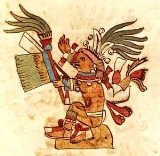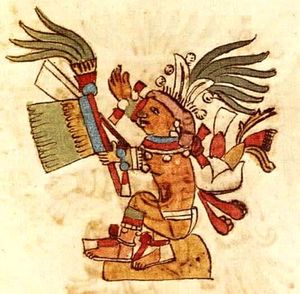
Centeotl
Encyclopedia

Aztec mythology
The aztec civilization recognized a polytheistic mythology, which contained the many deities and supernatural creatures from their religious beliefs. "orlando"- History :...
, Centeotl (also known as Centeocihuatl or Cinteotl) is the masculine deity of maize
Maize
Maize known in many English-speaking countries as corn or mielie/mealie, is a grain domesticated by indigenous peoples in Mesoamerica in prehistoric times. The leafy stalk produces ears which contain seeds called kernels. Though technically a grain, maize kernels are used in cooking as a vegetable...
.
According to the Florentine Codex
Florentine Codex
The Florentine Codex is the common name given to a 16th century ethnographic research project in Mesoamerica by Franciscan friar Bernardino de Sahagún. Bernardino originally titled it: La Historia General de las Cosas de Nueva Espana...
, Centeotl is the son of the earth goddess, Tlazolteotl
Tlazolteotl
In Aztec mythology, Tlazolteotl is a goddess of purification, steam bath, midwives, filth, and a patroness of adulterers. In Nahuatl, the word tlazolli can refer to vice and diseases. Thus, Tlazolteotl was a goddess of filth , vice, and sexual misdeeds...
and solar deity Piltzintecuhtli
Piltzintecuhtli
In Aztec mythology, Piltzintecuhtli was a god of the rising sun, healing, and visions, associated with Tonatiuh. The name means "the Young Prince". It may have been another name for Tonatiuh, but he is also mentioned as a possibly unique individual, the husband of Xochiquetzal. He was the lord of...
, the planet Mercury
Mercury (planet)
Mercury is the innermost and smallest planet in the Solar System, orbiting the Sun once every 87.969 Earth days. The orbit of Mercury has the highest eccentricity of all the Solar System planets, and it has the smallest axial tilt. It completes three rotations about its axis for every two orbits...
. Another myth claims him as the son of the goddess Xochiquetzal
Xochiquetzal
In Aztec mythology, Xochiquetzal was a goddess associated with concepts of fertility, beauty, and female sexual power, serving as a protector of young mothers and a patroness of pregnancy, childbirth, and the crafts practised by women such as weaving and embroidery...
. The majority of evidence gathered on Centeotl suggests that he is usually portrayed as a young man (although a debate is still ongoing), with yellow body colouration. Some specialists believe that Centeotl used to be the maize goddess Xilonen. Centeotl was considered one of the most important deities of the Aztec era. There are many common features that are shown in depictions of Centeotl. For example there often seems to be maize in his headdress. Another striking trait is the black line passing down his eyebrow, through his cheek and finishing at the bottom of his jaw line. These face markings are similarly and frequently used in the late post-classic depictions of a Maya
Maya religion
The traditional Maya religion of western Honduras, Guatemala, Belize, and Mexico is a southeastern variant of Mesoamerican religion. As is the case with many other contemporary Mesoamerican religions, it results from centuries of symbiosis with Roman Catholicism...
n maize god.
Worship
In the TonalpohualliTonalpohualli
The tonalpohualli, a Nahuatl word meaning "count of days", is a 260-day sacred period in use in pre-Columbian Mesoamerica, especially among the Aztecs. This calendrical period is neither solar nor lunar, but rather consists of 20 trecena, or 13-day periods...
(a 260 day sacred calendar used by many ancient Mesoamerican cultures), Centeotl is the Lord of the Day for days with number seven and he is the fourth Lord of the Night. In Aztec mythology, maize (which was called Cintli in Nahuatl, the Aztec spoken language) was brought to this world by Quetzalcoatl
Quetzalcoatl
Quetzalcoatl is a Mesoamerican deity whose name comes from the Nahuatl language and has the meaning of "feathered serpent". The worship of a feathered serpent deity is first documented in Teotihuacan in the first century BCE or first century CE...
and it is associated with the group of stars known commonly today as the Pleiades
Pleiades (star cluster)
In astronomy, the Pleiades, or Seven Sisters , is an open star cluster containing middle-aged hot B-type stars located in the constellation of Taurus. It is among the nearest star clusters to Earth and is the cluster most obvious to the naked eye in the night sky...
.
At the beginning of the year (most likely around February time), Aztec workers would plant the young maize. These young maize plants potentially were used as symbolism for a pretty goddess, most likely Xilonen, Princess of the Unripe Maize. Xilonen is usually depicted carrying fresh maize in her hands, bare-breasted and sitting down in a modest manner. An interesting conflict exists in that some historians believe Xilonen, otherwise known as 'the hairy one' and Centeotl are the same deity. When the seeds were planted, bringing about brought a ritual dance which occurred in order to thank Mother Earth and more specifically Centeotl. These dances became increasingly more prominent as the warmth of the sun brought about great prosperity for the Aztecs in the form of sprouting maize canes. This festival has been compared to the more Western maypole festival due to the similarity of their celebrations (dancing for spring, feasting, etc). These festivals were probably very pleasant for the Aztecs, judging by similar festivals in other civilizations. A major custom in Mexico during this festival period was for female Aztecs, regardless of marital status to loosen their ponchos and let down their hair. They would proceed to dance bare-breasted in the maize fields in order to thank Centeotl for his work. Then each female would pick five ears of corn from the field and bring it back in a grand procession while singing and dancing. Women in these processions were the promises of food and life in the Aztec world. Traditionally massive fights would break out as people tried to soak one another in flower pollen or scented maize flour. Also flower petals were thrown in ceremonial fashion over people who were carrying the ears of corn.
Corn was rather essential to Aztec life and thus the importance of Centeotl cannot be overlooked. It can be seen from countless historical sources that a lot of the maize that was cultivated by the Aztecs was used in sacrifices to Gods. Usually at least five newly ripened maize cobs were picked by the older Aztec women. These were then carried on the female’s backs after being carefully wrapped up, somewhat like a mother would wrap up a newborn child. Once the cobs reached their destination, usually outside a house, they were placed in a special corn basket and would stay there until the following year. This was meant to represent the resting of the maize spirits until the next harvesting period came around.
These five cobs were also symbols for a seemingly separate goddess. This highly worshipped goddess was known as Lady Chicomecoatl, Seven Serpents. She was the earth spirit and the lady of fertility and life, seen as a kind of mother figure in the Aztec world and was the partner of Centeotl.
External links
- Chicomecóatl. Encyclopædia Britannica. 2010. Encyclopædia Britannica Online. 22 Feb. 2010

